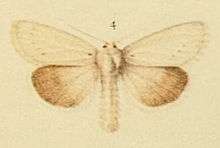Chortodes morrisii
Chortodes morrisii, or Morris's wainscot, is a moth of the family Noctuidae.
| Chortodes morrisii | |
|---|---|
 | |
| Form bondii | |
| Scientific classification | |
| Kingdom: | |
| Phylum: | |
| Class: | |
| Order: | |
| Family: | |
| Genus: | |
| Species: | C. morrisii |
| Binomial name | |
| Chortodes morrisii (Dale, 1837) | |
| Synonyms | |
| |
It is found in western and southern Europe.[1][2][3] In Britain it is limited to Devon and Dorset, while the form bondii, previously occurring in Kent, is thought to be extinct.
Technical description and variation
A. morrisii Dale (= bondii Knaggs) (49 g). Larger than the preceding species (Photedes extrema), chalk white, with faint grey dusting towards termen in the males; a curved series of black vein spots represents the outer line; no marginal spots; hindwing dark grey, paler in female; the fringe white; the abdomen is longer and thinner, the pectus and palpi smoother, less woolly, than in extrema. [4] The wingspan is 26–34 mm.[2]
Biology
The moth flies in June and July.
The larvae feed on stems of tall fescue (Festuca arundinacea).[5]
Subspecies
- Chortodes morrisii morrisii
- Chortodes morrisii sohnretheli (Püngeler, 1907) (Italy, named in honour of Otto Sohn-Rethel)
References
- Savela, Markku (13 May 2020). "Chortodes morrisii (Dale, 1837)". Lepidoptera and Some Other Life Forms. Retrieved 12 August 2020.
- Gustafsson, Bert (12 November 2009). "Photedes morrisii". Naturhistoriska riksmuseet. Retrieved 6 January 2013.
- Wall, Mike. "2346 Morris's Wainscot (Chortodes morrisii)". Hantsmoths. Retrieved 6 January 2013.
- Warren, W. in Seitz, A. Ed., 1914 Die Großschmetterlinge der Erde, Verlag Alfred Kernen, Stuttgart Band 3: Abt. 1, Die Großschmetterlinge des palaearktischen Faunengebietes, Die palaearktischen eulenartigen Nachtfalter, 1914

- Wikisource:The Moths of the British Isles/Chapter 15#301